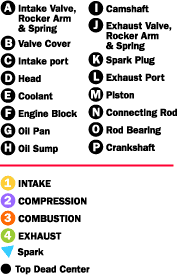
The Four Stroke Engine
The internal combustion engine converts petrol into motion and is found in almost all of today's road vehicles. It doesn't take a genius to guess that there are four main stages in a four stoke engine. These are
Intake Stroke
Compression Stroke
Combustion Stroke
Exhaust Stroke
These four stokes describe the piston movement within the engine.

1. The intake stroke: this is the first of the four strokes in the combustion cycle. As the piston moves away from the top of the cylinder, the intake valve opens. The downward movement of the piston creates a vacuum inside the cylinder and ambient pressure pushes in a mixture of air and fuel. Just after the piston reaches the bottom of the cylinder, the intake valve closes.
2.
The compression stroke: this begins as the
piston starts to move upward in the cylinder. The intake valve closes, trapping
the air-fuel mixture in the cylinder. Upward movement of the piston compresses
the air-fuel mixture into a very small area. Compressing the mixture is very
important for developing maximum power. The higher the compression, the greater
pressure exerted on the piston when the air/fuel mixture is ignited. Compression
also "pre-heats" the mixture which helps it to burn more efficiently.
3. The combustion stroke:
this begins as the compressed air/fuel mixture is ignited in the combustion
chamber. A spark plug, located in the cylinder head, creates an electrical spark
in the combustion chamber which ignites the air/fuel mixture. The burning fuel
rapidly expands, creating a very high pressure against the top of the piston.
This pressure drives the piston downward. The downward motion provides the power
that turns the crankshaft and drives the wheels to propel the vehicle. Up and
down movement of the piston on all four strokes is converted to rotary motion by
the crankshaft.
4. The Exhaust stroke:
this is the final stroke of the cycle. As the piston approaches the end of the
power stroke, the exhaust valve opens. Pressure in the cylinder causes the
exhaust gases to rush past the valve and into the exhaust system. The piston
moves up the cylinder, pushing most of the remaining exhaust gases from the
cylinder. As the piston nears the top of this stroke, the exhaust valve begins
to close as the intake valve begins to open and this begins a new cycle.
(animation
taken, without permission from how
stuff works - good site for further information.)